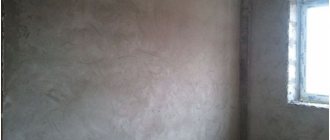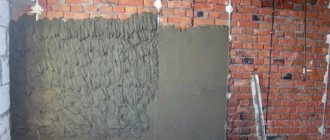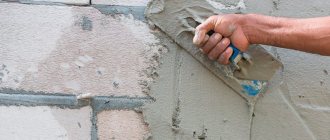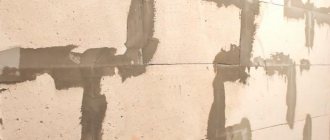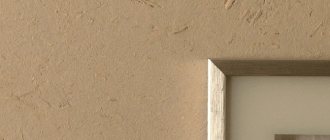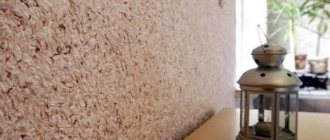Cement plaster is considered the most suitable option for finishing internal and external surfaces in residential, industrial, commercial and utility premises. This material is characterized by mechanical strength and resistance to moisture. With its help, you can plaster walls made of brick, cinder block, and cellular concrete “from scratch.” Finished coatings can be repaired in fragments. That is, to repair crumbling plaster, you do not need to remove the entire coating - just clean and finish part of the wall.
Material requirements
Subject to the proportions and rules for making the solution, it must meet the following requirements:
- The coating must be smooth without cracks or other defects. In addition, it should not move away from the wall surface.
- Cement plaster allows steam to pass through, so moisture will not accumulate under it, which significantly increases the service life of the coating.
- At the same time, cement plaster has thermal insulation properties and easily tolerates temperature changes.
The presence of cracks and other defects indicates improper preparation of the cement plaster solution.
Do-it-yourself mortar for plastering walls is made according to almost the same recipe, but depending on where it will be used, slight deviations from the technology are allowed.
Cement plaster Leveling MN Winter series, 40 kg
480
In stock
For leveling walls made of concrete, brick and cellular concrete. Finishing of facades and rooms with any level of humidity provides reliable protection of facades from atmospheric influences. Vapor permeable. Manual and mechanical application. For interior and exterior use. In an extended temperature range up to -10 °C.
BUY
Art. 2965
Moscow and region: Vidnoye, Belokamenny highway, ow. 10 151 Availability as of 02/05/2022 2nd Irtyshsky pr., 2A, building 3 5 Availability as of 02/06/2022 Central warehouse 4020 Availability as of 02/06/2022
Residential solutions
For bedrooms, living rooms and children's rooms, it is better to make mixtures based on cement grade 400 or 500, to which coarse sand and lime are added. The proportions are as follows: 2:6:1. In some cases, 1 part of gypsum is added to the solution to make the rough coating better. If such a solution was used, then for finishing work it is better to use sand of small rather than coarse fractions, and also add a little polyacetate glue to the plaster (mass part no more than 10%). This type of cement-based plaster will last about 15 years, and it does not require further decoration. If the desire to decorate your home appears, the wall can be painted, wallpapered or tiled.
For finishing living rooms it is better to use a solution with the addition of gypsum.
For finishing kitchens, corridors, bathrooms and similar rooms, you can prepare a cheaper solution. Cement mortars for plaster are prepared on the basis of a binder of grade 100 or 200. Sand is simply added to them in a ratio of 1:4, after which they are thoroughly mixed and diluted with water. All layers (rough and finishing) can be applied using plaster of the same consistency. The resulting coating will be of low quality, so most often it is decorated with paint, tiles, etc.
Cement plaster mixture, which does not contain lime paste, but clay, is used in those rooms where maximum insulation is needed. Alumina is both a cheap and effective thermal insulator. Typically the proportions of cement, clay and sand are as follows: 1:4:8. To increase mechanical strength, mineral fillers are added to cement-based plaster (no more than 10% by weight of the entire solution). Sometimes, to reduce the cost of the mixture, crushed asbestos is added to it, but such plaster can only be used in non-residential premises.
For finishing non-residential premises, you can use a cheaper solution with the addition of asbestos
Important! If you plan to finish hot surfaces, such as the walls of a stove, fireplace, chimney, etc., you must use only solutions with clay. If you prepare plaster solutions with your own hands with the addition of lime, the coating will crack very quickly.
Types of mixtures for plaster
Any plaster solution includes three main components - binder, water and filler. The binders are cement, clay, lime and gypsum, and they are often combined in different proportions. The filler is most often ordinary sand, but in ready-made factory mixtures it can be replaced with quartz and perlite sand, marble and granite flour, and stone chips. Additionally, plaster mixtures include modifying additives - coloring pigments, plasticizers and others.
Types and composition of plaster solutions
Depending on the type of binder, there are several types of plaster compositions:
- cement;
- clay;
- limestone;
- gypsum;
- cement-lime;
- cement-clay;
- clay-lime;
- lime-gypsum.
Types of plasters and their application
Mixtures with two or three binders are called complex. In addition to the composition, the ratio of components also plays an important role - based on this, solutions are divided into fatty, lean and normal.
A solution with a predominance of the astringent component is considered greasy. During the drying process, such plaster shrinks and cracks, as a result, re-treatment of the walls is required. It is not difficult to determine the fat content of the working mixture: when stirred, it sticks to the trowel and remains on the walls of the container in a thick layer.
If there is an excess of filler in the mixture, it is a lean solution. It is almost not subject to shrinkage, does not crack after drying, but does not adhere well to the surface and has too low strength. It is enough to lightly hit the wall for such plaster to fall off. When stirred, the thin solution easily slides off the trowel, leaving virtually no trace.
“Fat” and “skinny” plaster, which is better?
A normal solution is moderately plastic, it is easy to mix, and if you put a little mass on a trowel and let it slide, a thin, uniform layer will remain on the surface. It is this composition that ensures maximum adhesion to the surface being treated and creates a durable, reliable coating.
Normal plaster mortar
Popular ready-mixes
| Blend name | Characteristics | Price |
| UNIS plaster | Moisture- and frost-resistant, does not shrink, and withstands weathering well. Can be applied in layers up to 30 mm without reinforcement. Solution proportions: 0.16-0.2 liters of water per 1 kg of dry mixture. The solution consumption for a layer thickness of 5 mm is 6-8 kg/m2. The viability of the finished solution is 2 hours. Packaged in 25 kg bags. | From 280 rub. |
Cement plaster OSNOVIT Flywell | Frost-resistant, easy to apply, can be used for external and internal walls. Solution proportions: 0.3-0.42 l of water per 1 kg of mixture. With a layer thickness of 5 mm, the consumption is 9-10 kg/m2. The viability of the solution is 3 hours. Packing – 25 kg bag. | From 240 rub. |
Cement plaster Weber Vetonit | It has increased resistance to low temperatures, is moisture resistant, very plastic and easy to apply. The proportions for mixing the solution are 1 liter of water per 4 kg of mixture. Consumption for a thickness of 2 mm – 2.5 kg/m2. The viability of the solution is 3 hours. Drying time is from 2 to 7 days. | From 360 rub. |
Cement plaster "Starateli" | Waterproof, flexible, easy to apply. Forms a durable coating that is not prone to cracking and shrinkage. Mixing proportions: 0.26-0.28 liters of water per 1 kg of mixture. Solution consumption – up to 2 kg/m2. The viability of the solution is 1.5 hours. Packaged in 25 kg bags. | From 188 rub. |
| Decorative plaster UNIS Shuba-Decor | The base is white cement, the filler is marble chips. It is resistant to moisture, low temperatures, does not shrink, and is easy to apply. Mixing proportions: 0.18-0.2 l/kg. The viability of the solution is 1 hour. Packaged in 25 kg bags. | From 423 rub. |
Decorative plaster Knauf Diamant | Colored mixture on a cement base, filler – quartz sand. It has water-repellent properties, tolerates low temperatures well, and does not fade for a long time. Mixing proportions: 7.5 liters of water per 25 kg of mixture. The viability of the solution is 1.5 hours. Packaged in 25 kg bags. | From 340 rub. |
If you have no experience in plastering, it is recommended to choose ready-made mixtures - this way you will be sure of the correct ratio of components.
Prices for popular types of plaster
Plaster
What kind of plaster should be used for external surfaces?
Cement plaster mixtures for external work are manufactured using approximately the same technologies as materials for interior finishing. If lime is used as an additional component, then it should be 2 times less than in the case of internal surfaces. The fact is that external walls are subject to more serious loads, so they must first of all be strong, and then beautiful.
Cement plaster for external use is subject to more severe loads
External plastering is carried out in three stages, each of which requires specific plaster mixtures:
- For spraying. This layer is made to increase the reliability of contact between the plaster and the wall. It is applied in a thin layer of no more than 3 mm, and it is simply thrown onto the surface, so cement mortars for plastering walls must be liquid. For production, you will need Portland cement of a grade of at least 400. To one part of this material add 2 parts of sand and 0.1 part of the adhesive base. To increase adhesion to concrete substrates, you can add a small amount of liquid soap or dishwashing gel to the solution.
- The next layer is called soil. It must be durable, so the proportions of cement, sand and mineral filler are as follows: 1:3:1.
- After the primer layer has dried, a covering is applied. The proportions of the solution are the same as for spraying, but it is recommended to use fine sand.
The more layers of plaster, the lower the strength of the coating, so it is better to try to level the surface the first time.
For external work it is better to give preference to higher quality cement
Why does one solution have different proportions?
Leveling plasters consist of several layers that have different functions:
- the spray is intended to create a strong connection between the base material and the overlying, main leveling layer;
- the covering is designed to give the main leveling coating the required evenness, and sometimes smoothness (the required surface quality for gluing wallpaper, applying paint);
- primer – the main leveling material, applied in one or more layers.
Since the functions are different, the solutions differ in their proportions and components. For example, for covering you need a finer filler, since the degree of roughness of the finish depends on the size of the grains. For spraying, the mixture is made thinner than for soil. Confusing the compositions for different layers is a violation of the finishing manufacturing technology.
applying a layer of spray
base layer
cover
The period from the moment of mixing the plaster mass to the beginning of its setting is called the life span. At this time, the plaster solution is mobile and can be applied, giving the mixture the desired shape. The lifespan depends on the types of components and composition. For example, gypsum has a short lifespan. To increase or shorten this period, additives are added to the mixture - hardening accelerators or retarders.
In addition to these additives, to give the plaster mixture the necessary qualities, antifreeze (for plastering walls in winter), antifungal and other additives are introduced. Any additives require a fairly precise dosage, since they have their own chemical formula. Their excess can significantly deteriorate the properties of the finished coating.
Compliance with the ratio of plaster components is important. Therefore, when mixing a mixture of individual components or diluting ready-made dry formulations, follow the recommended proportions. This is the only way you will create a plaster stone with the desired qualities.
Independent production of cement-sand mortars
Before making a mortar for plaster, it is important to remember that such materials consist of a main binder (in this case cement), a filler (the cheapest and most accessible option is sand, but there may be other minerals), as well as additional components, which increase the thermal insulation, hydrophobic and other qualities of the plaster. A solution for cement plaster is diluted with water; its consistency, which is called fat content, depends on the amount of liquid. Fatty, normal or liquid formulations are used for various purposes.
On a note! Fat cement mortar for plastering walls contains a lot of binder. After such a solution dries, cracks may form on the surface. An insufficient amount of cement and sand can lead to the coating simply falling off the wall after a short time. For optimal solution quality, it is necessary to mix the main components in approximately 1:3 proportions.
The simplest and most common type of this material is a cement-sand mixture. The manufacturing proportions depend on the type of binder used. If Portland cement grade 400 or higher was selected, then 8 portions of sand per portion of cement will be required. For grade 100 material, you will need only 2 portions per 1 part of binder.
The preparation of ordinary plaster is as follows:
- Measured portions of cement and sand are mixed in a container.
- Then water is gradually added to it, constantly stirring the solution using a drill and a mixer attachment.
- After the consistency approaches the thickness of sour cream, you need to leave the solution to infuse for 15 minutes and then mix it again.
- In order for the solution to retain its plasticity index when drying, a small amount of PVA glue, soap base or dishwashing gel (no more than 2%) is added to it.
When preparing a solution, first mix sand and cement in the required proportion, and then gradually add water
Tools and materials needed for work
To obtain the composition yourself, you will need the availability and use of the following materials and tools:
- An electric drill with a mixer attachment or a professional mixer.
- Water, preferably filtered.
- Screened cement and sand cement.
- Lime dough or milk.
To independently obtain the composition, you will need the availability and use of certain materials and tools.
Production of cement-lime mortars
Work on the production of such materials begins with slaking lime. For this operation you will need:
- lime;
- capacity;
- clean cold water;
- personal protective equipment (goggles, gloves, thick clothing).
First of all, dry lime is immersed in a container and filled with water. Lime slaking is accompanied by a violent exothermic reaction, so the volume of lime and water should not exceed 30% of the container volume to prevent splashing of the material.
The preparation of cement-lime mortars begins with slaking lime
After 10 minutes, the reaction will subside, so you will need to add water again and leave the mixture to steep for about 1 hour. After this, add some water again, cover the container and let it brew for 2 weeks.
You should know! When using quicklime, the above reaction will occur on the walls, causing the plaster to crack.
After two weeks, you need to remove the lime from the container and rub it through a sieve with a 3 mm mesh. Then mix it with cement in a separate container, and then add sand. For 1 part of cement, it is recommended to use 1 portion of lime and 3 sand. Then you should pour a small amount of water and mix the plaster thoroughly.
Slaked lime is rubbed through a fine mesh sieve.
Cement mortars cannot be soaked with water after they have dried, so it is better to prepare a small amount of material so that it does not have time to dry in the container.
Types of plaster mortars, their composition and proportions
In fact, plaster coatings are artificially produced stone. We can influence the characteristics of this stone already at the stage of preparing the relevant components, dosing, mixing, applying to the wall and creating appropriate conditions for hardening of the composition.
In the mixed composition, each of the components does its job:
- binds other components (astringents that react chemically with water, forming crystalline bonds);
- serves as a frame that already has strength, creates a structure (fillers are mainly chemically inert), creates a thermal or noise barrier (for example, perlite sand);
- becomes a medium in which particles of materials are placed and, at the same time, participates in the chemical transformation of the binder (water or solvents in polymer compositions);
- contribute to the quality of the solution itself and the properties of the artificial stone (various additives);
- give color to the solution and finished plaster (dyes and pigments).
All together, these components form a solution, which, when transformed, becomes an artificial stone.
The following are used as binders:
- cements (mainly Portland cement, also for plaster compositions...);
- plaster (alabaster and plaster are found on the counter);
- lime (quicklime and boiling water);
- clay;
- various polymer resins.
Additional components
In some cases, additional ingredients are added to the formulations:
- Ground quartz. The fraction of this material can be from 0.1 to 6 mm. It is added to enhance the decorative properties of plaster and improve its resistance to acidic environments.
- Barite sand. This material protects surfaces from exposure to radio frequency waves. Plasters with such a substance are needed in areas with high background radiation, in various enterprises and in medical institutions.
- Crushed marble. This substance increases the strength characteristics of the composition, as well as its decorative properties.
- Mica. Makes the coating immune to ultraviolet waves.
- Metal shavings. Significantly increases compressive strength, but is susceptible to corrosion, so its use is not always justified.
- Expanded polystyrene. This material is added to plaster to increase thermal insulation performance.
Purpose of the components of the plaster mortar
As we already know, the plaster mixture consists of many different components. Each of which is important and performs its own functions. An excess or deficiency of one of the components of the solution will lead to a loss of quality. That is why it is important to know the purpose and functions of the components of the mixture.
Binder in plaster mortar
If the plaster solution contains only one binder, the composition is called simple. If there are two or more binders - complex. Not all binders get along with each other. For example, gypsum and cement are chemically unfriendly to each other. Therefore, they are used separately or with other binders.
cement
gypsum
clay
All binders, except polymers, are mineral substances, which is why plasters have the same name. Gypsum, cements and lime are pre-treated thermally, as a result they lose water and are able to react to its presence. When combined with water, these substances form saturated solutions and create crystals.
Liquid in plaster
The solution usually contains more water than is required for crystal formation. Liquid is also needed to give the mixture mobility (workability). In this case, excess moisture can be harmful (the strength of the solution decreases). It is for this reason that the ratio of water and other components must be observed.
Fillers
The production of binders, in addition to clay, requires a lot of costs, so they are much more expensive than fillers such as sand or sawdust. In addition, a solution containing only binders cracks when hardening. Therefore, to reduce the amount of binders (the cost of the solution), as well as to reduce cracking, fillers are introduced into the composition.
Fillers also give solutions a certain structure, for example, coarse sand is used for “bark beetle”; for other decorative mixtures, artificial or natural fibers and shell fragments are used as fillers.
It is better to purchase decorative mixtures ready-made. Their composition was developed and tested in practice by specialists.
Rough (leveling) plaster more often than other components has to be prepared on site. The consumption of leveling plaster mixture is higher, and the cost of a mixture prepared by yourself is lower.
Special additives for plaster mortars
To provide the plaster solution with the desired properties, modifying additives (universal and narrowly targeted) are used. Additives affect the binder (cement), enhancing or neutralizing its individual properties.
In solutions, additives perform the following functions:
- accelerate/slow down the process of crystal formation (setting), for example, for gypsum, the retarder is bone glue, milk, PVA;
- increase frost resistance (ferric chloride and other salts);
- improve plasticity (serve for some retention of water in the solution, prevent the process of delamination of the mixture), for example, liquid glass;
- increase the strength of the mixture (for example, reinforcing fibers (fiber) or additional binders).
Step-by-step technology for applying cement plaster
Before applying the solution, it is necessary to remove the old layer of plaster.
Before you begin applying the plaster solution to the surface, it should be carefully prepared. Preparatory activities include the following processes:
- Removing old coatings.
- Cleaning from grease stains, paint residues, dust and so on.
- Primer treatment.
- Installation of reinforcing mesh (not required for external finishing).
Before starting work, you need to prepare the following:
- Container for plaster.
- Spatulas and trowels for applying material.
- As a rule, a trowel and a grater for surface treatment.
Tools for preparing and applying cement plaster
First stage
After all the preparatory work has been carried out, as well as the required amount of solution has been prepared, you can begin to apply the first layer of material. This layer is called spray. The strength of contact between the plaster and the wall depends on it, so it is important to do everything correctly. Instructions for spraying:
- Add a little water and adhesive base to the finished solution, then mix thoroughly.
- Place the plaster on a spatula or trowel and spread it onto the surface.
- Level the coating with half tint or rule.
On a note! For concrete walls, the thickness of this layer should be 3 mm, for brick 7 mm, for wood 10 mm.
Second phase
10 hours after applying the spray, a reinforcing mesh must be installed. For concrete or brick surfaces, you can use a regular mesh or painting reinforcing products; for wooden surfaces, shingles are better suited. Install the products on self-tapping screws around the perimeter of the mesh and in its center. Then you need to scoop the solution onto a wide spatula and transfer it to the surface. Using a trowel, the coating is leveled. Then they take the rule and smooth the wall with it, removing excess mortar. You need to make zigzag movements and walk along the entire wall from bottom to top, then repeat the procedure. The thickness of this layer should be no more than 5 cm, and it is called soil.
The second stage, called soil, is a layer of plaster that bears the main functional load
Third stage
After the wall has dried and gained strength (about 9 days are required), the finishing layer is applied - a covering. The mixture for plastering walls should be the same consistency as for spraying, and the thickness should be about 3 mm. Water is applied to the soil using a spray bottle, after which the surface is finished using spatulas and trowels. After the layer has dried, it is further processed with graters.
Compliance with the technologies for preparing and applying cement plasters is the key to successful repairs. Even a novice home craftsman can cope with these tasks.
How walls are plastered. Technology
The quality of plastering work depends on many factors:
- preparation of the base;
- solution recipes;
- method of application.
The end result should be a smooth, even surface without cracks.
Surface preparation
Before carrying out plastering work, the surfaces of the bases are cleaned. If there are cracks, they are sealed. The surface is moistened with water.
Applying plaster
There are two main methods used: throwing and spreading.
Throwing plaster
The solution is scooped up with a trowel, trowel, or plaster trowel and thrown onto the surface. For a thick layer of plaster, use a special plaster ladle.
Spreading plaster
For this method, a rule or trowel is used to apply the solution to the surface. The method is especially suitable for ceilings as it minimizes material loss.
After the solution has set, begin grouting.
Grout
Grouting is done using a slightly dried, but still sufficiently plastic mortar using special trowels or trowels.
Grouting is done in a circular motion; in this case, the protrusions are cut off and the recesses are filled. Wetting the surface is used to form a “cement laitance”.
For finishing grouting, special trowels are used to cover the working surface with felt or felt.
Universal cement plaster Frontpro Standard Winter series, 25 kg
366
In stock
For leveling walls with a layer of 5 to 40 mm. from concrete, brick, stone, aerated concrete and foam concrete, as well as for leveling cement-lime and cement-sand bases. It is used inside and outside buildings (facades, basements and rooms with any degree of humidity). It has high crack resistance and provides reliable protection of facades from atmospheric influences. Fiber reinforced. Apply manually or mechanically. In an extended temperature range up to -10°C. Color grey. Weight 25 kg.
BUY
Art. 2736
Moscow and region: 2nd Irtyshsky pr., 2A, building 3 151 Availability as of 02/06/2022 Central warehouse 1361 Availability as of 02/06/2022
Universal cement plaster Frontpro Standard, 25 kg
282
In stock
For leveling walls with a layer of 5 to 40 mm. from concrete, brick, stone, aerated concrete and foam concrete, as well as for leveling cement-lime and cement-sand bases. It is used inside and outside buildings (facades, basements and rooms with any degree of humidity). It has high crack resistance and provides reliable protection of facades from atmospheric influences. Fiber reinforced. Apply manually or mechanically. Color grey. Weight 25 kg.
BUY
Art. 5102
Moscow and region: Central warehouse 987 Availability as of 02/06/2022



